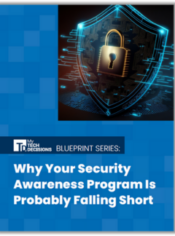HID Global has pinpointed a handful of top trends in the access control and identity technology industry for 2018. The company distinguishes increased Cloud and mobile access adoption, more focus on securing the Internet of Things (IoT), and data analytics in particular that can be expected to develop more intelligent, connected experiences in the next year.
“Trusted identities will emerge this year as the fundamental building blocks for organizations to create environments that connect people, places and things,” says Samuel Asarnoj, senior vice president, corporate strategy & business development, HID Global. “The user experience will be redefined by mobile, IoT and Cloud technologies and deliver new capabilities for the future.”
Following are five significant trends in 2018 that will influence how organizations leverage the power of trusted identities, according to the company.
Organizations embracing the benefits of the Cloud
Increased awareness of the Cloud’s ease of deployment, flexibility, connectivity options and productivity benefits will escalate adoption. Access control Cloud platforms with APIs and SDKs will fuel new software solutions that expand choices for organizations to get the most out of their investments. Cloud-based card issuance will drive adoption due to its simplicity, security and cost structure, while governments increasingly investigate how printed IDs can be complemented by Cloud-issued mobile citizen IDs.
Cloud authentication and credential management will further integrate mobile devices, tokens, cards and machine-to-machine endpoints. And digital certificates in the IoT will draw upon the trusted Cloud services to deliver and manage certificates across thousands of devices.

Looking to purchase the perfect access control technology for your organization at the best price? This guide will show you how.
The Technology Manager's Guide: Tips for Buying Access Control TechnologyMore connected devices and environments drive focus on securing the IoT
Digital certificates will become a core component for adding trust in the IoT by issuing unique digital IDs to printers and encoders, mobile phones, tablets, video cameras and building automation systems, plus a broader range of things like connected cars and medical devices.
Apple iOS 11 “read” support of NFC will fuel adoption of IoT-based applications such as brand protection, customer loyalty programs and other use cases that will further drive the need to enhance security in the IoT.
Mobile access reaches tipping point for mass market adoption
In 2017, mobile access went mainstream and adoption will accelerate even further in 2018. Maturity in mobile solutions and integration into other systems, coupled with mobile’s ability to enhance user convenience, improve operational efficiency and provide higher security will drive accelerated growth for mobile access and mainstream adoption.
Card emulation, the NFC mode most coveted for mobile access control, remains reserved exclusive to Apple Pay; this leaves Bluetooth as the communication standard for cross-platform mobile access support. Still, organizations will invest in readers and other infrastructure that supports NFC and BLE to prepare for future possibilities.
The concept of Physical Identity & Access Management (PIAM) will drive convergence of physical and digital security to a single credential, putting identity at the center of all use cases. Government, finance, energy and other regulated markets will emerge as the forerunners using these solutions for secure access to buildings, email, websites and VPN.
New converged identity models that use Cloud authentication and mobile devices are also emerging, such as the ability to verify a person’s presence at a location, mobile IDs that validate physical citizen IDs, and smart cards that authenticate users to enterprise resources.
Data analytics will drive risk-based intelligence for predictive models and new capabilities
Devices, access control systems, IoT applications and other solutions connected to the Cloud will provide robust data for advanced analytics. Insights from these analytics can be used to optimize workflow solutions and provide more seamless access for end users.
Predictive analytics and biometrics will play a crucial role in people-centric security and address employee demands for workplaces to deliver premium, more individualized services. Analytics will also help reduce downtime in the enterprise, spur factory automation and improve compliance via condition monitoring that is based on real-time location and sensing solutions.
If you enjoyed this article and want to receive more valuable industry content like this, click here to sign up for our digital newsletters!










[…] business needs a system in place to ensure that only authorized personnel can access your premises. Access control can use a variety of methods, such as a pin code or biometric scanners to keep unwanted visitors […]